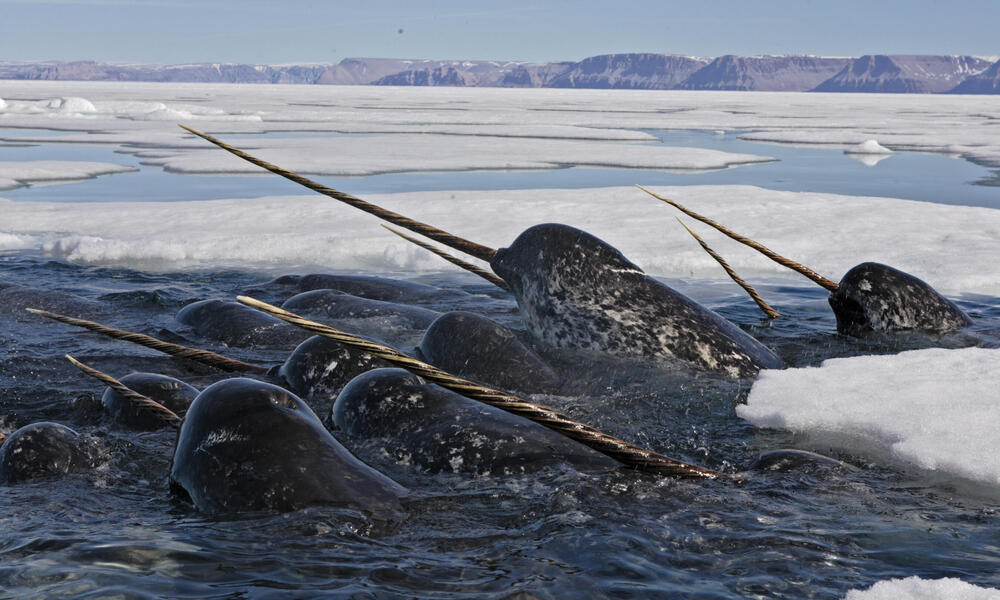What are narwhals? Besides being in the film, Elf, narwhals are called the unicorns of the sea. Are Narwhals Real?
That is because of the big, hornlike tusk that sticks out from their faces. A long time ago, when the narwhal tusks washed up on shore, people thought the tusks belonged to unicorns.
But that is not the case. Those tusks are teeth that grow from the upper jaws of narwhals. That is not the only amazing thing about narwhals.
Narwhals: Are Narwhals Real?
There are lots more amazing facts to find out about these majestic animals. Narwhals are pale in color. Older narwhals are almost all white, juveniles are blue-black, and infants are blue-gray. As adults, they weigh about 3,500 pounds and they can get up to 20 feet long. They also happen to have two teeth.
One of them is that big, long, spiral one that gets up to 8 feet long. It grows up through the narwhal’s lip and has tons of nerve endings in it.
This makes it sensitive to things around it. Experts think that the tusk is there to impress females or to battle rivals. Female narwhals sometimes grow a small tusk too, but it is not as prominent.
Narwhals are related to bottlenose dolphins, belugas, and harbor porpoises. They like to dine on halibut, Arctic and polar cod, shrimp, and squid.
Narwhals are elusive in lots of ways, but experts still know some things about them. They live in the Arctic waters and sometimes travel around Greenland to eastern Russia. Most of the time, they swim slowly, but when predators chase them, they move fast. They are hunted by polar bears, orcas, and native Inuit people.
For the Inuit, the narwhal skin is an important source of vitamin C. Narwhals like to swim at the top of the sea, but they can dive 5,000 feet below the waves.
In the summer months, narwhals swim close to the shore. In the winter, they swim out to sea and live under ice. When they are on the move, narwhals travel in pods of 10-100 and sometimes even more than that!
They communicate by making all kinds of clicks and trills. If you ever spot a pod of narwhals, they might be crossing their tusks. This is called “tusking.” No one is sure what tusking is, but it is likely a kind of friendly contact or a method for cleaning tusks.
Besides being hunted by predators, narwhals are at risk from the effects of climate change.
Their small population size, limited environment, and love for dining on Arctic fish are also at risk of vanishing. All this negatively impacts narwhals.
Some experts think that the narwhal is more sensitive to climate change than the polar bear! Narwhals might be at risk of vanishing, but we can help. Some methods include taking part in a symbolic adoption. A person’s cash donation will get them gifts such as a certificate, an animal fact sheet, and a plush stuffed narwhal.
If adoption is not possible, letters or emails to government leaders can help make them aware of the risks for narwhals. And of course, learning about narwhals and sharing their story is a big help too.

Introduction
Narwhals are a type of whale in the Monodontidae family, most closely related to the Beluga whale
• Around 13-16 feet long, males weigh up to 3500 pounds, females up to 2200 pounds
• Feed on Greenland halibut, the polar and Arctic cod, shrimp and Gonatus squid
• Narwhals prefer waters far offshore covered in sea ice where they eat at great depths in complete darkness.
Range
• 25,000-45,000 left, listed as Near Threatened by IUCN
• Habitat range is the Atlantic Arctic, narwhal is one of the most northern cetaceans
• Lots of studies done in the Baffin Bay (between Greenland and Canada).
Age Distribution
Evolutionary strategy= high longevity, part of optimal life history
• Longevity of narwhals could be seen as adaptation to mitigate the population effects of drastic changes in climate.
Reproduction
Reach sexual maturity between 6-9 years
• Females give birth to a calf every 3 years, with a gestation period about 14 months and they give birth in spring.
Narwhal’s Tusk
In males, the left of two teeth will grow and become its tusk, usually about a third to half the length of it, about 6 feet!
• Recent discovery: Martin Nweeia has discovered that the narwhal’s tooth has hydrodynamic sensor capabilities with millions of tiny nerve connections. That’s capable of detecting changes in water temperature, pressure, and particle gradients (salinity).
• Other theories say that it is used for capturing prey or making holes in sea ice.
• Females almost never have a tusk meaning it cannot serve a critical function for survival.
Narwhal’s Tusk – Mating
The most accepted view is that male narwhals use the tusk to determine social rank .
• Male narwhals can be seen carefully crossing their tusks as though sword fighting
• Behavior might help maintain dominance hierarchies
• Have not been observed using their tusk for fighting or other aggressive behavior.
Narwhal’s Tusk – Exploitation
Tusks exported from the Arctic, perhaps by the Vikings, reached Europe, the Mediterranean, and even the Far East as early as the Middle Ages.
• The large tusks of adult males are sold in the specialty souvenir market both inside Canada and in the global marketplace. The price of narwhal ivory has increased substantially over the past years.
Migration
• Narwhals migrate to their southern wintering grounds in Oct/Nov, traveling by leads and cracks in ice pack .
• Baffin Bay is one of the few areas with increased sea ice concentrations and sea ice thickness
• Reductions in the availability of open water in the Baffin Bay pack ice may have deleterious consequences because of recurring migration paths.
Climate Change and Narwhals
A recent assessment of the sensitivity of all Arctic marine mammals to climate change ranked the narwhal as one of the three most sensitive species, primarily due to its “narrow geographic distribution. As specialized feeding and habitat choice, and high site fidelity” (Laidre et al. 2005).
• Sudden changes in weather conditions freeze shut the leads and cracks. So, they were using, causing ice entrapments where hundreds can be trapped in a small opening and die.
Conclusion
• Narwhals are amazing and unique creatures, and although they are not severely struggling now, scientists predict a more critical population level in the future
• How to combat this? !Make narwhal trade illegal worldwide! !Mitigate climate change !Further research should include:
• Best management practices in terms of conservation.
• Response of narwhal habitat from climate change impacts.
• Climate change’s impact on foraging and prey availability.



